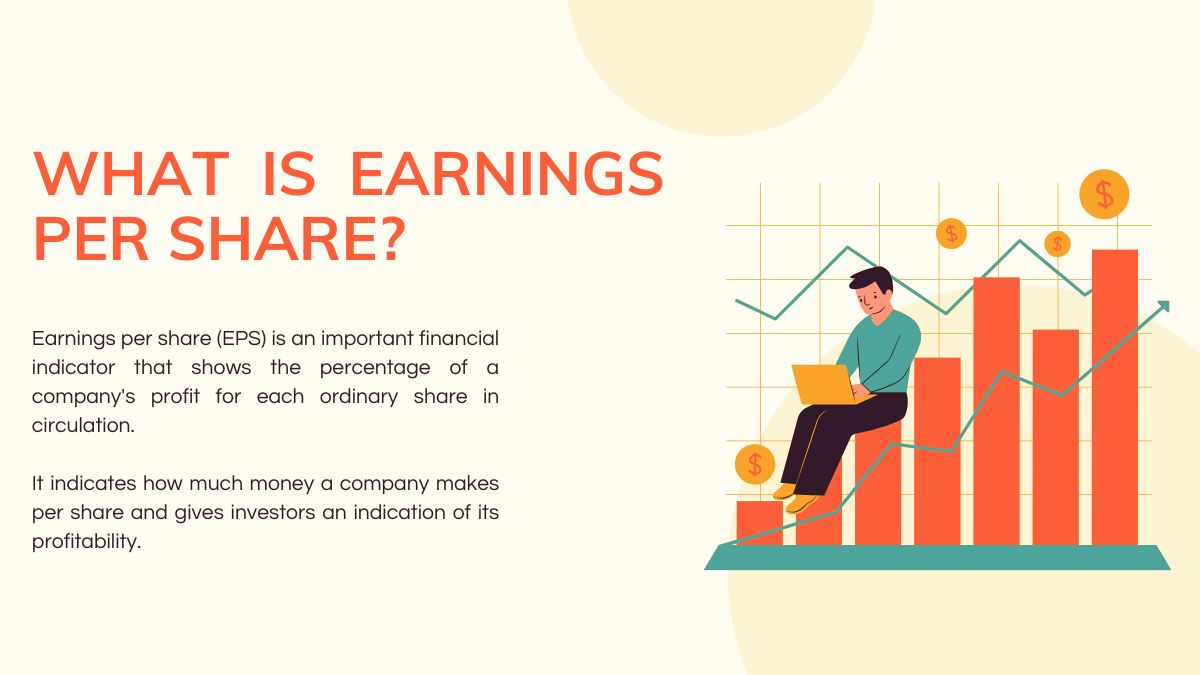Earnings per share (EPS) is a financial indicator that shows investors whether the company is profitable. EPS is calculated by dividing a company’s net profit by the number of shares outstanding. Savvy investors take a company’s earnings per share into account when making investment decisions.
Understanding how it affects stock selection can help you make sound financial decisions. If you have questions about how earnings per share affects your investment portfolio, you should consult a financial expert.
What is EPS (Earning Per Share)?

Earnings per share (EPS) is an important financial indicator that shows the percentage of a company’s profit for each ordinary share in circulation.
It indicates how much money a company makes per share and gives investors an indication of its profitability.
How is EPS Calculated?
The core components of the EPS basic version are:
- Net income: The total income of a company after deducting all expenses such as taxes, interest, depreciation and amortization. This amount is recognised in the company’s income statement.
- Preferred dividends: Dividends are payments to shareholders, with those who own special shares coming first. When a company issues preference shares, it deducts the dividends paid to these owners from its net profit.
- Average common shares outstanding: This is the average number of common shares issued by a company and held by investors during a given period (e.g. quarter or year). This number may fluctuate due to share issues or buybacks.
Basic EPS formula
EPS = (Net Income – Preferred Dividends) / average number of ordinary shares outstanding
Let’s look at a simplified example:
Company XYZ
Net income (annual): ₹8 crore
Preferred Dividends: ₹80 lakh
Average common shares outstanding: 5 crore
Calculation of basic EPS:
Net profit available to ordinary shareholders:
₹8 crore (net profit) – ₹80 lakh (Preferred Dividends) = ₹7.2 crore
Basic EPS:
₹7.2 crore / 5 crore shares = ₹1.44 per share
This means that during the year, Company XYZ earned a profit of ₹1.44 for every ordinary share outstanding.
What Are the Two Types of Earnings Per Share?
The two main types of earnings per share (EPS) are:
Basic EPS
Basic earnings per share is, as the name suggests, a simplified method of calculating earnings per share that only takes into account the ordinary shares in circulation.
- The standard calculation: The most common type of EPS. It’s calculated by dividing a company’s net income (less preferred dividends) by the average number of common shares outstanding.
- Focus: Reflects the percentage of a company’s income represented by each common share.
- Best for: Quick profitability comparisons between companies.
Diluted EPS
Diluted EPS includes various types of securities that can be converted into common stock, such as employee stock options and convertible bonds.
We calculate diluted EPS using a larger number of shares than basic EPS. It’s lower because the denominator is larger.
- Factors for dilution: Takes into account the potential impact of stock options, convertible bonds, warrants, or other securities that can be converted into ordinary shares.
- Assumes a worst-case scenario: Assumes that all of these dilutive securities are converted, increasing the number of shares outstanding. This leads to a more conservative estimate of the company’s potential earnings per share.
- Best suited for: Evaluating potential worst-case scenarios for profitability and understanding the potential impact of converting outstanding securities.
Why two types?
Both types of EPS are important because:
- Basic EPS provides a simple snapshot of current profitability.
- Diluted EPS provides a more conservative outlook and helps investors understand a company’s potential earnings power if all dilutive securities were exercised.
Read More:
- What Is Market Capitalization? How To Calculate Market Cap And Understand Company Value
- Enterprise Value to Sales: A Deeper Dive into Company Valuation
What is EPS used for?
1. Profitability indicator
- Earnings per share: Earnings per share is a measure of a company’s net profit that measures earnings per outstanding share. This makes it easier to understand a company’s profit potential on a ‘per share’ basis.
- Comparison of companies: Investors analyze the earnings per share of several companies, especially those in the same sector, to determine their relative profitability. A higher EPS often indicates a company that is more successful at making money.
2. Valuation tool
- Price-earnings ratio (P/E ratio): Earnings per share is a key component of the price-to-earnings ratio, a popular valuation metric. The P/E ratio (share price/EPS) indicates how much investors are willing to pay for each dollar of a company’s earnings.
- Evaluating the market price: By comparing a company’s P/E ratio to similar companies or the market average, analysts can determine whether a stock may be overvalued or undervalued.
3. Tracking performance over time
- Growth or decline: Tracking EPS trends over several quarters or years shows whether a company’s profitability is increasing, decreasing or remaining stable. Rising EPS is often a positive sign for investors.
- Insights into company management: Earnings per share trends can provide indirect information about a company’s management performance and strategic decisions.
4. Informing investment decisions
- Potential returns: Although not a guarantee, companies with higher or growing earnings per share can signal the potential for share price appreciation and higher dividends in the future.
- Risk assessment: Analyzing EPS trends along with a company’s debt and future prospects helps investors assess the overall risk of an investment.
What are the Limitations of EPS?
Here is a summary of the main limitations of earnings per share (EPS):
- No consideration of debt: Earnings per share focus only on a company’s profitability and ignore all financial obligations. Two companies can have the same EPS, but one may be highly leveraged, making it a riskier investment.
- Manipulation: Despite existing accounting rules, companies can use certain methods to artificially inflate their earnings per share (EPS). These include: Share buybacks: Reducing the number of shares outstanding increases earnings per share without affecting actual earnings. Timing of income/expenses: Manipulating the timing of when revenue or expenses are recognised to positively impact certain reporting periods.
- Ignores cash flow: Earnings per share is an accrual basis accounting measure and therefore does not directly reflect a company’s cash flow. A company may have high earnings per share but struggle with weak cash flow needed to pay debt and maintain operations.
- Limited comparability: Comparing the EPS of companies from different industries can be misleading. Industries have different capital structures and accounting practises, which makes comparisons less meaningful.
Earnings per share is not an indicator of future growth as it is a historical figure. Even if a company has achieved high profits in the past, this is no guarantee of similar performance in the future.
How Can Limitations Be Minimized?
- Don’t rely on EPS alone: Always use EPS in conjunction with other financial metrics, such as:
- Debt-to-equity ratio (debt valuation)
- Price-to-book ratio (comparing the share price with the actual value of the company)
- Cash flow statements (to understand the cash flow situation)
- Looking at trends: Analyse a company’s EPS trends over time rather than focusing on a single time period.
- Consider industry context: Compare EPS within the same industry to gain more reliable insights.
- Qualitative analysis: Supplement your EPS analysis with research on the company’s management, competitive landscape and general market trends.

